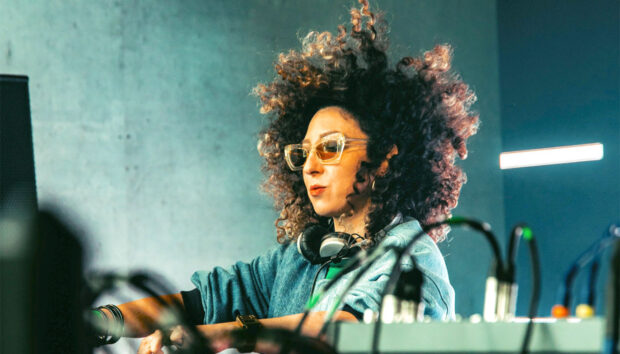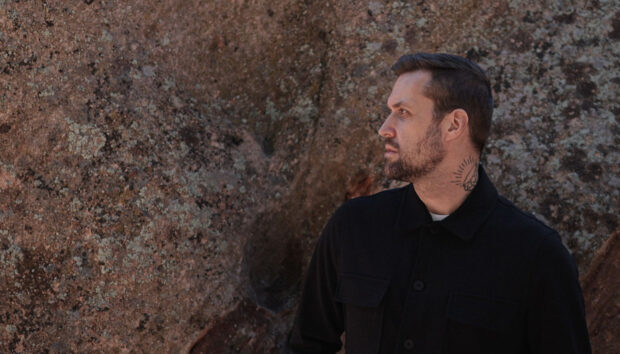
Try watching your favorite horror movie with the sound off. Do those terrifying scenes suddenly seem flat and unconvincing? That’s because sound brings immersion to cinema – and this is particularly important in horror films, which aim to provoke a strong emotional reaction in the viewer.
Horror uses a distinctive palette of sound effects to get pulses racing, from ghostly voices and ambiences to piercing dissonance and sudden impacts. In this article, we’ll show you how to make five of these scary sound effects. Use these spooky sonic tricks to build suspense, create ominous atmospheres, and heighten shocking moments.
Jump to these sections:
- What makes a horror soundtrack?
- How can I make my music scarier?
- How to make 5 scary sound effects for scoring horror films
- Start using scary sound effects in your music
Follow along with this tutorial using Kithara and Conflux, powerful scoring tools available in Kontakt 8.
What makes a horror soundtrack?
A horror soundtrack doesn’t just need music – it should also be packed with spooky sound effects that heighten the action on screen. Whether it’s the creepy ambience of an abandoned mineshaft, a twisted monster voice, or a shocking “jumpscare” moment, these effects will make your soundtrack complete. Read on to learn about the tools and techniques you’ll need to create them.
How can I make my music scarier?
To make your horror movie music more scary, try adding ghostly effects such as reversed reverb, deep ominous drones, or “jumpscare” impacts. You should also make sure to write chords and melodies in a minor key – or depart from the key entirely by creating piercing dissonant clusters. There are numerous tried and tested techniques for giving music an extra shock factor. We’ll explore some of them in detail below.
How to make 5 scary sound effects for scoring horror films
Ghostly voice
Is your dialogue not sounding spooky enough? Or maybe you want to add ethereal whispers to the background of a scene? You can use this simple sound design trick to turn a spoken vocal into a creepy transmission from another plane. All you need to do is add reverb – in reverse.
Here’s how it works. This is our dry vocal.
We’ll start by reversing the audio. Many DAWs let you do this in a click or two.
Next we’ll add reverb. We chose a simple Vocal Chamber preset from Neoverb, an intelligent reverb plug-in from iZotope.

Then we resample the result as audio, and reverse it again. Now the voice is running the right way, but the reverb tails go backwards, giving the speech an otherworldly quality.
Let’s take this trick further. Some reverb and delay plug-ins have a built-in “reverse” function with its own spooky flavor. One such effect is Psyche Delay, which was inspired by the backwards tape experimentation of the 1960s. It’s available both as a standalone plug-in and as part of Guitar Rig 7.

By hitting the Reverse button, Psyche Delay gives you instant ethereal sound FX. Here it is applied to our dry vocal. We turned the Dry/Wet mix up to maximum so that you’re only hearing the delay signal.
For a final touch, we can combine both the reverb and delay effects to create an extra spooky vocal.
Ominous drone
Horror films aren’t just about shocking moments that jolt you out of your seat. Quieter scenes help build atmosphere and suspense, and music plays a key role in this.
Here’s how to create a deep, foreboding drone that can help set a scene.
You can use a synthesizer to make drones, but pitching down real-world sounds often gets more atmospheric results. That’s because the viewer hears a familiar sound transformed into something uncanny, which heightens their sense of unease.

We created our drone out of pitched down samples of a guitar-like instrument called the Ronroco. For this we used Kithara, a powerful sampling instrument with a rich library of acoustic string samples. Many of Kithara’s samples use processing and extended techniques to turn familiar instruments into otherworldly textures. It’s a great tool for scoring horror movies.
If you’re playing more than one note with your drone, try to keep it in a minor key to evoke a dark, ominous mood. Here we’re playing the root and third notes of a minor scale.
Spooky ambience
Film scoring helps give viewers a strong sense of place, immersing them in the world of the movie. In horror movies, this means creating unsettling ambiences for haunted houses, dank caverns, decrepit basements, and other such scary places.
Here’s how to use sound design techniques to transform simple field recordings into haunted ambience.
We’ll start with two recordings we found in a sample library. The first was recorded inside a car. We’ll use it to create an ominous sub rumble.
The second is the sound of wind in the Rocky Mountains. We’ll process it to create spooky wailing sounds.
Let’s start with the rumble. All we need to do is remove higher frequencies from the car recording using a filter or EQ. We used Ozone 11 EQ, a pro-grade equalizer that’s available for free.

This creates a subliminal rumble that will set the viewer on edge. It could be the perfect sonic backdrop for a spooky cavern or mysterious underground facility.
Now let’s transform our wind recording into scary background FX. For this we’ll use Guitar Rig 7. This powerful sound design tool is more than just a virtual rig for guitarists – it lets you combine dozens of effects to create otherworldly sounds ideal for scoring.

First, a filter with high resonance transforms the wind into spooky wailing tones. We used Guitar Rig’s Doppel Filter, which gives us two filters in one. We then automated the filter cutoff so that it roams around randomly.
Next, we can make the sound spookier with delay and reverb – lots of it. We added Psyche Delay (in Reverse mode again) to give the sound an ethereal edge, then two reverb effects to add murk and distance. Here’s how it sounds, combined with the rumble sound underneath.
Dissonant texture
Dissonance is a powerful way to raise tension and evoke fear.
Dissonance means combining notes that clash. You can easily create a dissonant chord by playing three notes right next to each other on your MIDI keyboard.
Dissonance is often used in horror to heighten shock and fear. The best-known example is the stabbing string motif in Alfred Hitchcock’s Psycho.
We’re going to use strings to create our own dissonant texture. We’ll layer them with a synthesizer for a more modern feel.
We’ll use Conflux, a powerful hybrid instrument that makes it easy to layer synthetic and acoustic sounds in scoring.

First, we’ll combine string samples with a wavetable synth source for a rich, piercing sound. Add a little reverb with Conflux’s powerful effects suite – and hey presto, a dissonant texture.
It’s sounding a bit static so far. We can spice things up by making our sound layers slide around in pitch.

We can do this using Conflux’s LFOs. We’ve assigned them to alter the pitch of our synth and string layers – but in opposite directions. The result is a clashing dissonant sound that really makes the skin crawl.
Jumpscare
The most memorable moments in horror movies are those sudden frights that set the adrenaline pumping. Sound helps to frame and heighten these moments, telling the viewer that something is coming and then enhancing the impact when it arrives.
Here’s how to create a jumpscare using dissonant textures and percussion.

We’ll start by reusing the dissonant strings we made in the previous section. We just need to automate parameters like volume, filter cutoff, and pitch, so that the sound gets more intense as the fright approaches. You can see the automation lanes in the image above.
Next, we’ll add dramatic, booming percussion. For this we’re using Action Strikes, a Kontakt instrument that’s tailor made for adding impactful percussion to movie scores.

We used booming metal hits and epic tom toms. As with our strings, these drums should start less intense before suddenly getting faster and sharper. The “jump” then ends with a throbbing sub impact.
Here’s how the drums and dissonance sound together. At the climax, we also layered in some of the spooky voice we created earlier, for an extra ethereal touch.
Start using scary sound effects in your music
In this article, we’ve shown you how to make 5 scary sound effects to elevate your horror soundtracks. From ghostly voices to shocking jumpscares, we’ve demonstrated how simple sound design techniques can be used to create seriously spooky audio.
If you want to start using these techniques in your own movie scores, it’s important to have the right tools for the job. Kithara and Conflux are powerful hybrid instruments designed for scoring. Featuring deep sample libraries and extensive tweaking options, they’re handy tools for your next horror soundtrack. Both are available in Kontakt 8, the flagship sampling platform from Native Instruments.















